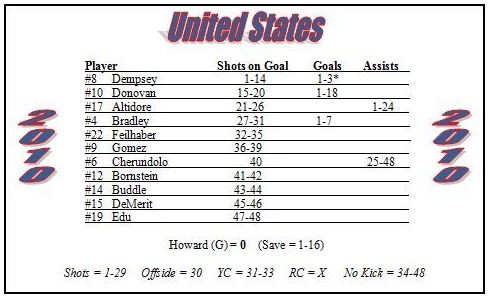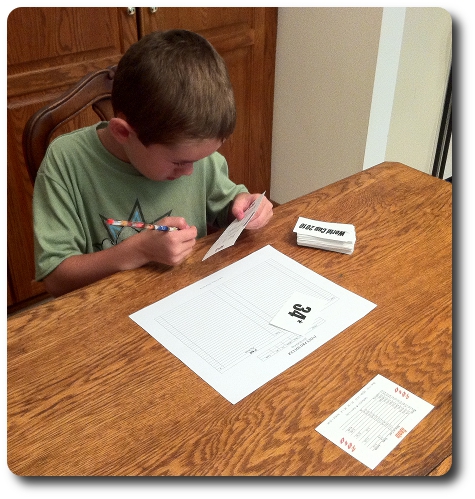
The Basics:
- For soccer fans ages 6 and up
- For 1 player (solitaire)
- About 15 minutes to play
Geek Skills:
- Counting & Math
- Reading & Writing
Learning Curve:
- Child – Hard
- Adult – Moderate
Theme & Narrative:
- Relive and replay any soccer match of your choice of the 2010 World Cup
Endorsements:
- Gamer Geek rejected!
- Parent Geek approved!
- Child Geek approved!
Overview
Index Pro Soccer: 2010 World Cup is a solitaire game where a player matches up different teams from the 2010 World Cup and plays the game out. Each team has statistical information that is used to determine the odds of success, game length, and outcome of events. It is a soccer statistical lovers dream come true as the player can replay again and again classic matches or come up with their own to see what might have been an incredible victory or a historic flop.
The game is comprised of 96 Transaction Cards, 64 Game Cards (32 of which are starting lineups for each team and the other 32 are the team’s statistical information), and 1 score sheet. A player will need a pencil in order to keep track of the scores and events throughout the game. The game comes on thick perforated paper and must be carefully removed before play.
Game set up is a simple affair. The player picks two teams they want to see in a match. With a total of 32 teams to choose from, the player can have fun mixing and matching not only historical matches played in the 2010 World Cup, but coming up with their own “dream matches”, too. The length of the game is determined by adding each team’s “Shots on Goal Per Team” value and then dividing it by 2. The resulting value determines how many shots on goal (i.e. “kicks”) are allowed per Half. This means if the player chooses two teams who statistically took a large number of shots on goal, the game will be much longer than two teams who took less. Once the game length has been determined, the player decides which team will have the ball first (coin toss, if they like). It’s time to play some soccer!
Index Pro Soccer: 2010 World Cup is a stats game with an element of luck thrown in to provide a certain level of randomization to adjust possible outcomes. Based on the stats of the soccer players on the team, the team’s stats, and the opposing team’s stats, the odds of success shift. The randomizer for the game is a deck of 96 cards referred to as the Transaction Cards. There are two sets of cards numbered 1 through 48 twice. The first set is simply the number values 1 through 48, and the second set is numbered 1 through 48 with an asterisk (*). The asterisk is not used unless a team card specifically has that number with an asterisk included. All other times, the Transaction Card value is the number listed. It should also be noted that Transaction Cards, once used, are reshuffled back in the deck.
Kick Determination
The first thing the player always does for each team is determine the effects of a kick. This is done by randomly selecting a Transaction Card and comparing the value on the team card. There are five possible results:
- Shots: one of the team members takes a shot on the goal
- Offside: one of the team members is offsides
- Yellow Card (YC): one of the team members is given a Yellow Card
- Red Card (RC): one of the the team members is given a Red Card
- No Kick: the team looses possession of the ball

The United States Team Card
Shots
If the Transaction Card value indicates the team takes a shot on goal, the player draws another Transaction Card to determine which player takes the shot. If that value results in a team member who can make a goal, the player next determines if the goal is successful. This is done by drawing another Transaction Card and reducing the value by the opposite team’s Defense Rating (indicated by the Goalie). If the modified Transaction Card value is within the Goals range, the team scores. The player randomly selects one more Transaction Card to determine if another team member assisted. The results are recorded with the player who kicked the ball, the name of the team member who assisted, the new game score, and time is advanced by one. The possession of the ball is now given to the opposite team.
If the goal is missed, the Goalie has a chance to save the ball. The player draws a Transaction card and determines if the value selected is within the Goalie’s “Saved” range. If it is, the Goalie grabs the ball. If not, the ball goes out of bounds. The results are recorded with the player who kicked the ball, if the Goalie saved it or not, and time is advanced by one. The possession of the ball is now given to the opposite team.
If the Transaction Card value resulted in a player who could not take a shot at the goal, it is still considered a kick, but without a chance to make a goal. The Goalie has a chance to save the ball. The player draws and Transaction card and determines if the value selected is within the Goalie’s “Saved” range. If it is, the Goalie grabs the ball. If not, the ball goes out of bounds. The results are recorded with the player who kicked the ball, if the Goalie saved it or not, and time is advanced by one. The possession of the ball is now given to the opposite team.
Offside
If a player is found to be offsides, the possession of the ball is immediately turned over to the opposite team. The results are recorded. Time is not advanced.
Yellow Card
If a player is given a Yellow Card, the results are determine by how many Yellow Cards have been given to that team so far.
- First Yellow Card: opposite team takes possession of the ball. The results are recorded. Time is not advanced.
- Second or More Yellow Cards: A Free Kick is awarded to the opposite team. The player draws a Transaction Card for the opposite team’s Shots value to determine if here is a possibility of a goal. The same process is used to determine if the goal is success or not and the results are recorded. Time is not advanced.
Note: When determining the success of the Shot during a Free Kick, any Transaction Card values that result in anything other than Shots are ignored and the shot fails.
Red Card
If the player is given a Red Card, the opposite team takes possession of the ball, is awarded a Free Kick (as explained under “Yellow Card”), and is given 3 shots on goal attempts after the Half is over. No more than 3 extra shots on goal can be awarded, even if additional Red Cards are issued. The results are recorded. Time is not advanced.
No Kick
The opposite team takes possession of the ball. The results are recorded. Time is not advanced.
Scoring and Timing
Whenever a goal is successful, the team who scored gets a point. The team with the most points after the second Half wins. Only shots on goal reduce the total time left per Half. For example, if the time for the game in total was 24, each Half would have 12 total shots on goal. However, if a team is given the Red Card, the opposite team is allowed 3 shots on goal after the Half has completed.
Overtime and Sudden Death
If the game ends and both teams are tied, each team is given 5 shots on goal using the Free Kick rule (as described under “Yellow Cards”) until one team has more goals from the shots taken. If the teams are still tied, Sudden Death begins and each team is given 1 Free Kick to score. This continues until one of the teams misses a shot on goal and is behind in points.
Predictions
My oldest son loves soccer and was the obvious choice of my three little geeks to be the official Child Geek tester of Index Pro Soccer: 2010 World Cup. My oldest son also has a good grasp of numbers and can manage playing games with multiple steps much better than his other two brothers. Even so, I don’t believe this game will appeal to him. He is used to playing board, dice, and card games with 1 or more players. This is a solitaire game that does most of the work for you. All that is needed to play is understanding the flow of the game, having the time to play it, a pencil, and a piece of paper. The game does all the rest.
I carefully explained the game to my oldest son, who had many questions before and after. I showed him several examples of how the game is played and then asked him for his early thoughts. His response…
“This game looks really hard. I don’t know if I understand all of it.” ~ Liam (age 6)
A sensible and honest answer. The game, while not overly complicated, does have a lot of steps. These steps are hard to keep track of at first. Still, he was eager to learn and to try.
And so, we played the game.
Final Word
What constitutes a “game”? Dice? Cards? Little miniature pieces? Certainly not and yet this is what often comes to mind when we say “games”. Our children play games all day long, but these games hardly ever include any of the trappings of board, dice, and card games. They play games with their toys and their friends, with their pets and other family members.
Can we then reason that a “game” is anything that we do that brings us amusement? No, as I believe such a definition is a bit too broad. After all, watching movies and reading books is amusing, but you’d be hard-pressed to call such activities games.
Merriam-Webster suggests that a game is “a physical or mental competition conducted according to rules with the participants in direct opposition to each other”. Certainly, this is closer to our understanding of games, but this is a solitaire game and there is no opposition to speak of. Is Index Pro Soccer: 2010 World Cup a game?
Yes and no.
Index Pro Soccer: 2010 World Cup is a game, but also a simulation. It is a game in the sense that there is a level of competition taking place, but that is where it stops, as there is no competition with the player. The game is playing against itself as defined by its own rules and already knows all the possible outcomes. It then uses the player to move it forward as it simulates actions and outcomes of the soccer match.
In fact, I wrote computer programs that did pretty much the exact same thing that Index Pro Soccer: 2010 World Cup does at the gaming table. One program I wrote that I was particularly proud of simulated and printed the results of Ping Pong players based on a handful of stats and variable conditions. I would run this simulation again and again, recording the results, and figuring out the best possible values to make the best Ping Pong player.
Creating that computer program was a good deal of fun and it was exceedingly interesting to watch Ping Pong matches play out in front of me. I always knew what could happen, but never knew what would happen. Index Pro Soccer: 2010 World Cup has that same level of excitement and wonder as the game plays out in front of you.

My oldest little geek reviews the card to see if a kick scores a goal
Clearly, this is a game that will appeal to lovers of game/team stats and soccer fans. The game mechanics are streamlined and very easy to use, once you learn them. Best of all, the games are quick once you know how the game flows. I can finish 3 games in less than 20 minutes if I really put my mind to it. The end result is an enjoyable solitaire game that allows you to recreate your own 2010 World Cup or create matches between teams that never happened.
Index Pro Soccer: 2010 World Cup is an interesting experience and an enjoyable one. Even my 6 year old, once the game was learned, enjoyed it. He tells me he is going to make his own game using ideas from this one that is about fighting robots! I am eagerly looking forward to see what he comes up with! Until then, he has asked for this game a number of times to play. I must admit that I was surprised by this based on my earlier predictions.
Index Pro Soccer: 2o10 Wold Cup does have its faults, however, and they are pretty big ones in my book. Luckily, they are very easy to address and will make the game all the more enjoyable.
First, the rules for the game are very difficult to follow. All day at the office, I read technical manuals, complex Logical Data Models, and try to determine just what an executive is trying to tell me. Even with all of this experience, I had a hard time understanding the game rules.
The basics are there, but not enough is covered in the way of examples that show how the game flows in a meaningful step-by-step procedural way. And since this is a solitaire game that is heavily dependent on the player managing the game flow, not knowing what comes next immediately stops the game and kills it.
You can and will, eventually, get the rules down, but only through trial and error. I made several assumptions early on and broke the game in the process. I had to go back and more or less “guess” what needed to happen based on the core rules. When it worked, I wrote it down so I wouldn’t have to remember. After tinkering with it for a bit, I felt like I had it down and the game became very streamlined and easy to play.
Honestly, though, I really couldn’t tell you if I am playing the game correctly. A simple revision of the rules will go a long way to make this game more enjoyable and accessible to different groups of players.
Second, the game does not allow for any strategy or decision making. You literally flip a card over and review what happened based on that card value. I would have liked to have seen more decisions being given to the players, such as when to go for a shot on goal, swapping out different players who are sitting on the bench, and maybe even a couple of “special plays”. This would have made me feel more like a participant versus an observer. The game is not currently designed for this level of play, but I don’t see it being difficult to add, either.
Better yet, having the ability to create my own teams using existing team players from all the teams available would be awesome! A person could really get into making their own special starting lineup and seeing what happens when the best of the best go head to head! You could even make the game into an enjoyable 2 person experience if both players drafted their own teams!
All things considered, Index Pro Soccer: 2010 World Cup is an enjoyable solitaire experience. I recommend it to soccer fans and to educators who are looking for a good example of how stats influence outcomes and make predictions possible.
The game does not get my endorsement, sadly. There is not enough in the game that makes me feel that I am playing it. Just the opposite, in fact. It feels like the game is playing me. I will enjoy the game from time to time and especially during the next World Cup! I am also thrilled to see how my son has taken to it and look forward to seeing how his introduction to stats is going to influence his game choices and designs in the future.
If soccer is not your bag, the Gregory Game Company also has football and baseball!



